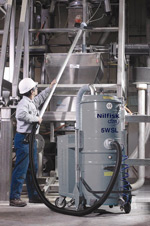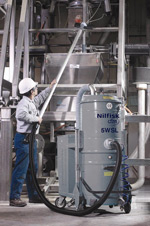
Combustible Dust Raises Explosive Issues
- By Paul R. Miller
- Dec 01, 2009

Nilfisk CFM vacuum.
By now, most manufacturers are familiar with the story of combustible dust. They've read about it in the newspaper, "Googled" it online, watched it on CBS's "60 Minutes" special1, or received a letter from the Occupational Safety and Health Administration informing them their facility is considered high risk for a combustible dust explosion. They have a solid picture in their minds of what an industrial explosion scene looks like: the remnants of a facility, a gaping hole, a collapsed roof, workers covered in soot and blood. It's like a well-craft ed movie scene, except it's real.
Combustible dust has been the culprit of deadly workplace blasts for decades, but not until the February 2008 explosion killed 14 people at the Imperial Sugar refinery in Port Wentworth, Ga., did the issue begin getting the attention it deserved. OSHA stepped in, reissuing its combustible dust National Emphasis Program, and the industrial world became inundated with statistics, definitions, and preventative measures. But with all of the media attention and new-found information regarding combustible dust explosions, very little attention has been devoted to the most common combustible dust-related incident happening daily at facilities across the United States: fires. Essentially precursors to explosions, combustibledust fires are often regarded as "a part of business," especially in heavy-industrial manufacturing facilities where eliminating hazardous dust is next to impossible. Although small dust-related fires might be the norm for some manufacturers, flames that don't lead to a deadly explosion should be considered a near miss. Yet, unlike explosions that often get top billing in newspapers and on the nightly news, small fires usually get just a few brief sentences, if they're covered at all. They also are rarely reported to state and federal agencies because, aside from random inspections; OSHA investigates significant incidents only if they involve a fatality or extensive injuries.2
John Astad, founder of the Combustible Dust Policy Institute, has taken the issue into his own hands, starting a grassroots effort to raise awareness and understanding of all facets of the combustible dust issue. Through his research, which includes combing the Web for news articles that contain keywords and calling on local fire departments, Astad discovered through media accounts that 80 percent of combustible dust incidents in 2008 were solely fires, and 30 percent of dust explosions occurred at facilities that had experienced prior related fires.3 Here are just some of the incidents Astad has come across through his research:
- In June 2008, New Jersey firefighters responded to a fire at a paper recycling facility when paper particles in the duct system became overheated and ignited. The fire chief confirmed similar fires happen several times a year at the location.4
- On June 20, 2009, five local fire departments converged on a fire at a sawmill in Pike County, Ohio. While the cause of this particular fire was unknown, the sheriff's office said the location is the site of fire calls from time to time because the dust related to cutting wood leads to easy combustion.5
- In the summer of 2008, a wood stove pellet plant caught fire twice in a six-week period. Both incidents led to an explosion. A spark that ignited wood dust was responsible for at least one of the fires. Local residents, who have felt up to four blasts, described the company as a "hazard."6
Combustible dust fires occur when three components of the fire triangle exist:
1. Combustible dust (fuel)
2. Ignition source (heat)
3. Oxygen in air (oxidizer)
Most industrial facilities have all three elements. If fire ignites in a contained area where combustible dust particles have accumulated, such as a duct system or overhead beam, the formula for an explosion is complete. While an initial blast can be devastating, it often stirs up additional dust, leading to a secondary blast that can take down an entire facility.
Maintenance and Housekeeping
Dust and debris are inevitable in the manufacturing sector, and the only way to completely eliminate combustible dust incidents is to shut down operations. Obviously, this is not an option, and so plants dealing with combustible dust must take the proper steps to educate themselves, decrease their risk, and be adequately prepared should a combustible dust incident occur.
A comprehensive maintenance plan is a solid first step in preventing a combustible dust-related fire or explosion and can greatly minimize the tragic effects of a secondary blast. By letting dust accumulate on surfaces, facilities are literally adding fuel to the fire. Efforts should be taken to ensure that dust deposits greater than 1/32 of an inch, the thickness of a paper clip, are promptly removed, according to OSHA's Combustible Dust NEP.7
While mops and brooms have their place in industrial facilities, the process of using them is time consuming and often creates dust clouds. They also are very limited in what they can clean. A properly equipped, HEPA-filtered industrial vacuum suitable for collecting combustible dust can get the job done in half the time and can be used to remove dust from machinery, floors, walls, and overhead pipes and vents (see "Combating Combustible Dust with Explosion-Proof Vacuums," page 17).
Aside from proper maintenance techniques to reduce dust buildup, Astad is spreading the word about best engineering practices. As outlined in the National Fire Protection Association's combustible dust standards, housekeeping alone will not minimize the severity and probability of occurrence. Employees and managers should be trained to recognize and prevent combustible dust fires, and facilities should have a damage control plan that includes sprinklers, explosion protection systems, and deflagration venting.
Action by OSHA
In April 2009, OSHA announced the beginning of a rulemaking process that one hopes will one day make the aforementioned recommendations mandatory. However, the process isn't free from criticism. OSHA has been accused of doing too little too late, and many are afraid any combustible dust regulation will be hurriedly passed through to quiet the masses or without consideration for how companies will pay for mandatory systems. And while Astad is critical of OSHA's Combustible Dust NEP, he certainly does not blame the agency and appreciates the steps it has aken thus far. "The current Combustible Dust NEP formulated through the Chemical Safety Board recommendations is a start, but stakeholders throughout industry still have a long way to go," he said.
Before a rulemaking process can proceed in a manner that adequately protects the workplace while allowing companies to remain profitable, regulatory agencies must fully recognize the scope of the issue, and that includes accurately accounting for each and every combustible dust incident, including fires, Astad said. "Many people are saying that OSHA doesn't have the resources, but that's not true if we all worked together," he said. "Local fire departments, authorities having jurisdiction, manufacturers, and those serving the industrial sector: We all have a stake in this, and we can all make a difference."
Dust-related fires and explosions have been happening since the dawn of manufacturing. While industrial fires are not 100 percent preventable, manufacturers should no longer view them as inevitable. The industrial sector has come a long way from the workplace tragedies of the Industrial Revolution; with endless resources of education and means of prevention at their fingertips, there's no reason for today's manufacturers to go up in smoke.
REFERENCES:
1. Is Enough Done to Stop Explosive Dust?. CBS News, "60 Minutes."
About the Author
Paul R. Miller is vice president and general manager of Nilfisk Industrial Vacuums (www.NilfiskIndustrialVacuums.com). He has more than 20 years of experience in the industrial vacuum cleaner industry, having served in various capacities throughout his tenure with the company. Nilfisk CFM's EXP vacuums are CSA-approved for use in Class I, Group D and Class II Groups E*, F, and G classified environments.